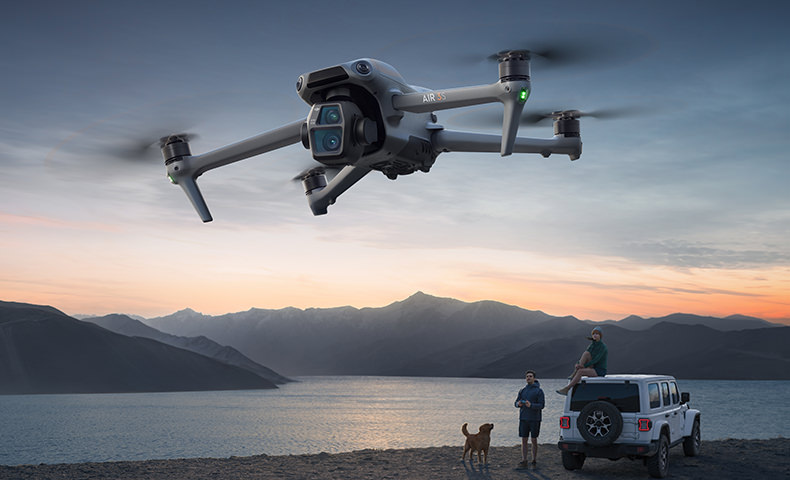CHASE THE VIEW
A dual-camera drone designed for travel photography, DJI Air 3S integrates a suite of advanced technologies. Featuring a 1-inch-CMOS primary camera and a 70mm medium tele camera, each with up to 14 stops of dynamic range, [1] Air 3S captures landscapes, portraits, and more in stunning detail. Both cameras support the new Free panorama feature, which allows flexible shooting-range selections. Additional new highlights include nightscape obstacle sensing [2] and next-gen Smart RTH for enhanced safety during nighttime photography. In each and every way, DJI Air 3S is designed to maximise every aerial moment.
| 1″ CMOS Primary Camera | Dual-Camera 4K/60fps HDR Video & 14 Stops of Dynamic Range [1] | Free Panorama, Seamless and Detailed |
| Nightscape Omnidirectional Obstacle Sensing [2] | Next-Gen Smart RTH With Enhanced Precision | 45-Min Flight Time [3] 20km Video Transmission [4] |
DUAL CAMERAS, UNMATCHED IMAGERY
DJI Air 3S features a dual-camera system consisting of a 1-inch-CMOS primary camera and a 1/1.3-inch-CMOS medium tele camera. The primary camera features a larger CMOS sensor and a 24mm lens, making it ideal for capturing expansive landscapes with enhanced clarity and a wide field of view. The 70mm medium tele camera excels at portrait and vehicle shots, offering compressed depth of field to highlight any subject with a bolder, more cinematic look.
| 1″ CMOS Primary Wide-Angle Camera | 1/1.3″ CMOS Medium Tele Camera |
| 3.2μm Large Pixel Size [5] | 2.4μm Large Pixel Size [5] |
| 24mm Format Equivalent | 70mm Format Equivalent |
| 50 MP | 48 MP |
| f/1.8 Aperture | f/2.8 Aperture |
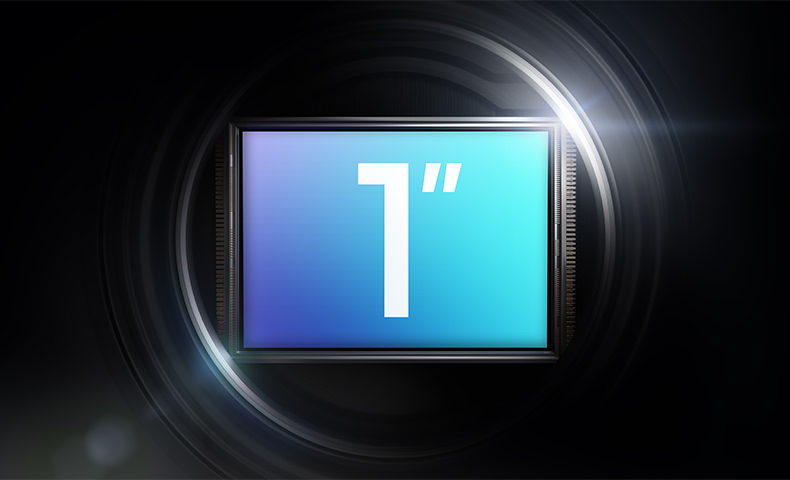
1″ CMOS PRIMARY CAMERA: BREATHTAKING DETAIL FOR TRAVEL PHOTOGRAPHY
The primary camera of DJI Air 3S integrates a 50MP 1-inch CMOS sensor, supporting 4K/60fps HDR and 4K/120fps video recording [6] as well as 10-bit D-Log M colour mode. This large sensor, enhanced by advanced image-processing technology and intelligent algorithms, preserves even minute details in low-light conditions such as sunsets and nightscapes, delivering shots that are simply, effortlessly breathtaking.
4K/60fps HDR Video
The latest HDR video mode offers up to 14 stops of dynamic range, [1] capturing cinematic footage in high-contrast scenes, such as detailed views of cloud textures and other elements during sunrise and sunset.
4K/120fps Video [6]
Enhanced resolution and frame rates add a vibrant perspective of cultural or sporting events, and open up exciting creative possibilities during post-processing.
10-bit D-Log M & HLG Video
Even in normal colour mode, Air 3S can record 10-bit video using H.265 encoding, delivering refined colour performance and greater flexibility in post, with the maximum ISO raised to 12,800. In D-Log M and HLG colour modes, the maximum ISO is raised to 3,200, allowing for greater brightness and more details in urban night scenes.
MEDIUM TELE CAMERA: UNFORGETTABLE PORTRAITS
The medium tele camera, with its 48MP 1/1.3-inch CMOS sensor, supports the same video specs and colour modes as the primary camera. This ensures visually consistent footage for streamlined post-processing. Its 70mm lens offers 3x optical zoom, allowing you to capture unique shots from a distance while highlighting your subject. And when you use Air 3S to orbit around a subject and record a 4K video, you can easily take detailed and expressive close-up portraits.
4K/60fps HDR Video
When capturing close-ups of vehicles against the sunset, the medium tele camera offers up to 14 stops of dynamic range [1] to vividly capture the rich, vibrant colours of the setting sun.
4K/120fps HDR Video [6]
When filming slow-motion videos at 4K/120fps during skiing, the medium tele camera can record high-resolution videos that are slowed down to showcase a skier's skills and even the most subtle movements.
10-bit D-Log M & HLG Video
Air 3S's medium tele camera also supports recording 10-bit video in normal colour mode using H.265 encoding, offering refined colour performance and greater flexibility in post. With 10-bit D-Log M mode enabled, the camera captures richer colour details and beautifully renders the vibrant lights of the city as evening falls.
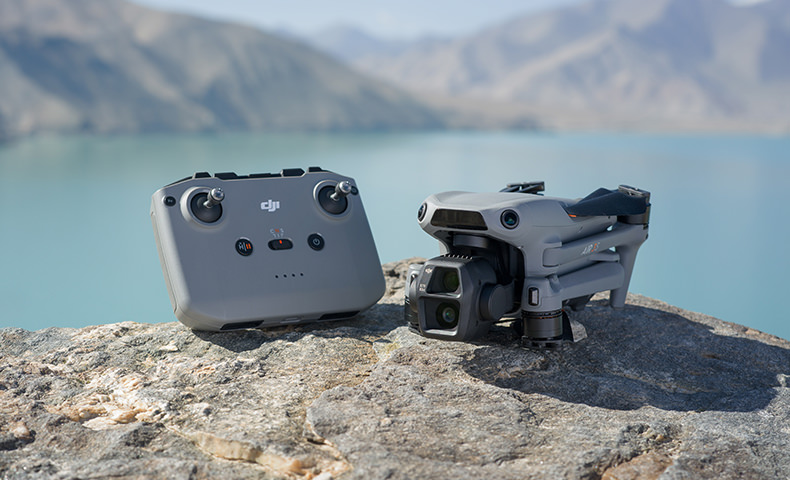
FREE PANORAMA
Both the primary camera and medium tele camera of DJI Air 3S offer Free panorama mode, letting you create seamless panoramic shots by stitching together multiple images with a manually selected subject or area. The wide-angle camera offers a broader FOV, boosting efficiency when capturing panorama photos. The medium tele camera significantly reduces image distortion, crafting your masterpieces into expansive shots with a wide perspective from multiple photos and rich details captured through its focal length advantages.
OMNIDIRECTIONAL VISION SENSING SYSTEM
DJI Air 3S supports the Advanced Pilot Assistance Systems (APAS). Additionally, as the first DJI drone to feature forward-facing LiDAR, Air 3S also features downward infrared time-of-flight (ToF) sensors and six vision sensors (two at the front, rear, and bottom) to achieve nightscape omnidirectional obstacle sensing. [2] This feature enables the drone to automatically identify and circumvent obstacles, such as buildings, during its flight and return paths, ensuring robust safety for nighttime photography.
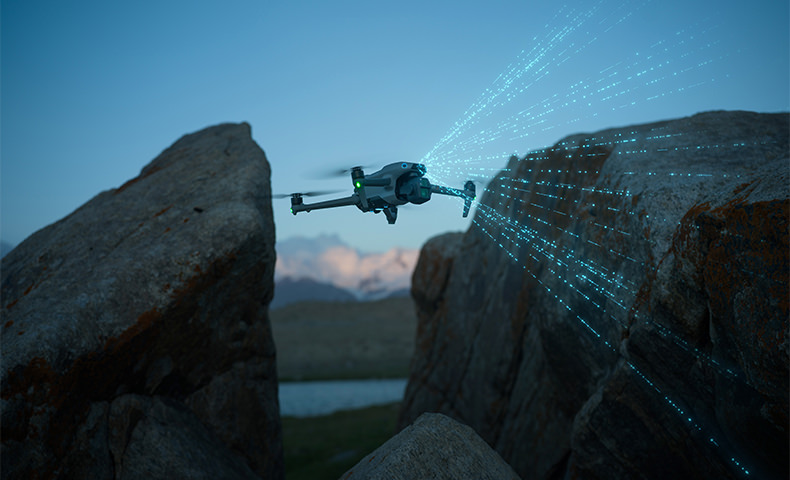
NIGHTSCAPE OMNIDIRECTIONAL OBSTACLE SENSING
NEXT-GEN SMART RTH
Non-GPS RTH
Powered by real-time vision positioning and map construction technologies, DJI Air 3S memorises flight paths when adequate lighting is available. This ensures a safe return even when taking off from locations without satellite signals, such as balconies. [7]
Nighttime RTH
With forward-facing LiDAR, DJI Air 3S can detect obstacles such as high-rise buildings and navigate upwards around them, [7] even in low-light conditions, ensuring safer returns at night.
ENHANCED VISION ASSIST
DJI Air 3S's Vision Assist provides a downward view in addition to the front, back, left, and right views to help you better understand your surroundings.
DJI Air 3S also provides Waypoint Flight and Cruise Control, among other advanced features, which allow you to pre-set flight paths and camera actions and quickly lock control stick inputs to unleash creativity.
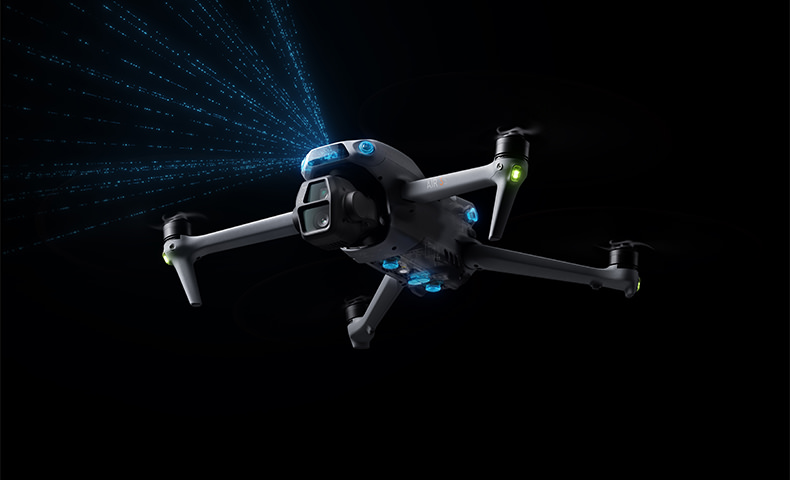
A NEW AIR AESTHETIC
DJI Air 3S features ActiveTrack 360° to keep any subject optimally in frame. Based on the surrounding flight environment, it automatically plans a flight path and adjusts framing to ensure stronger shots that keep your subject the centre of attention.
ActiveTrack 360°
ActiveTrack 360° allows Air 3S to automatically avoid perspectives with cluttered backgrounds.
Optimised Tracking Performance
Once tracking begins, DJI Air 3S can keep the subject in focus even if the lower half of their body is partially obscured by bushes or if they are standing on a bridge.
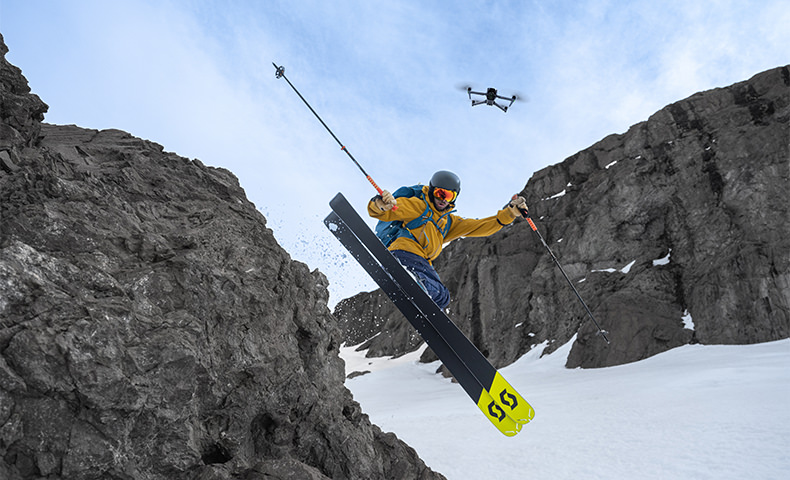
STAY FOCUSED
DJI Air 3S introduces a new Subject Focusing feature that keeps your subject in sharp focus, even during manual flight or when the subject moves off-centre. This feature allows you to fully concentrate on the more creative aspects of your shots like composition and camera movement.
SERIOUS AIR TIME: 45-MIN MAX
With up to 45 minutes of flight time, [3] Air 3S gives you enough time to scout locations, compose, nail your shots, and do it all over again and again.
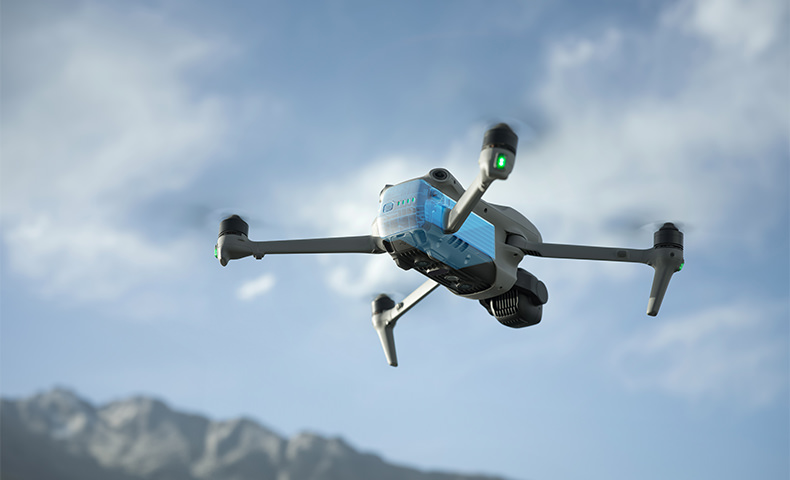
10-BIT O4 VIDEO TRANSMISSION
Powered by DJI O4 FHD video transmission technology, Air 3S delivers 10-bit video transmission at 1080p/60fps over distances of up to 20 kilometers. [4] Live feeds are reliably smooth and vivid, with ultra-responsive control for an improved overall flight experience.
DJI CELLULAR DONGLE 2 COMPATIBILITY
The DJI Cellular Dongle 2 [8] can be inserted directly into DJI Air 3S for seamless integration without the need for any extra accessories. In case of O4 signal obstruction or interference, you can rely on 4G connectivity for stable video transmission and drone control, enhancing flight safety and reducing disconnection risks.
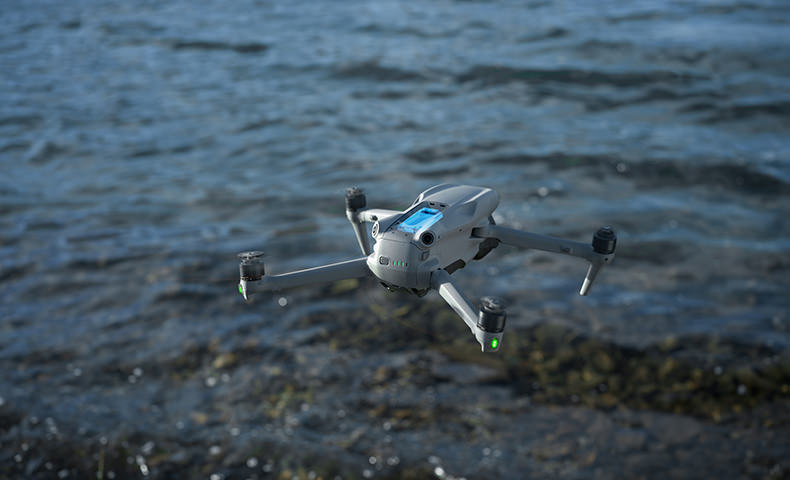
ATTENTION TO EVERY DETAIL
ALWAYS READY: 42GB OF BUILT-IN STORAGE
DJI Air 3S comes standard with 42GB of built-in storage. This allows you to start recording right away and avoid having to deal with microSD cards.
OFF-STATE QUICKTRANSFER
You can now send files from your Air 3S to a smartphone even when the drone is powered off. [9] Transfers to a computer can also be done with the drone powered off—simply connect Air 3S via a compatible USB cable.
BATTERY CHARGING HUB WITH POWER ACCUMULATION
The Battery Charging Hub supports PD fast charging and a power accumulation function, which allows you to transfer the remaining power of multiple low-power batteries into the battery with the highest remaining power. [10]
-
All videos and images on this page were shot using DJI Air 3S by professionals in strict compliance with local laws and regulations and have been variously edited in post-production. All videos and images are for reference only. Actual results may vary. Always observe local laws and regulations and ensure the aircraft has obtained relevant certifications and airspace authorizations before flying.
** All data on this page was collected with a production model of DJI Air 3S in a controlled test environment. Actual experience may vary depending on the environment, usage, and firmware version. DJI Air 3S must be activated via the DJI Fly app before use.
*** It is recommended to use the ActiveTrack 360° feature in open environments. Refer to the user manual for unsupported scenarios or those that may potentially interrupt recording. In complex environments with many obstacles, exercise caution when using Auto mode to ensure flight safety and personal safety.
**** All images, videos, and screen display contents about the product itself on this page are for reference only. Actual product effects (including but not limited to appearance, colour, and size) and screen display contents (including but not limited to backgrounds, UI, and illustrations) may vary.
14 stops of dynamic range are achievable for video on Auto mode but not for vertical or slow-motion video.
2. Conditions for enabling nightscape omnidirectional obstacle sensing: The drone's front, back, left, right, or top sides are within range of surfaces with discernible textures with illuminance that exceeds 1 lux. Similarly, the ground below is textured and diffusely reflective with a reflectivity above 20% (such as walls, trees, or people), also in lighting conditions with illuminance higher than 1 lux. DO NOT fly in severe weather conditions, such as in strong winds (wind speed of 12 m/s or more), snow, rain, lightning, or fog. DO NOT fly the aircraft 6,000 m (19,685 ft.) or higher above sea level. DO NOT fly the aircraft in environments where the temperature is below -10° C (14° F) or above 40° C (104° F). DO NOT take off from moving objects, such as cars or boats. DO NOT fly close to reflective surfaces such as water or snow. Otherwise, the vision system may not work correctly. When GNSS signals are weak, fly the aircraft in well-lit environments: the drone's front, back, left, right, and top sides are within range of surfaces with discernible textures with illuminance that exceeds 10 lux. Similarly, the ground below is textured and diffusely reflective with a reflectivity above 20%, also in lighting conditions with illuminance higher than 10 lux. The vision system may not work properly in dim environments. DO NOT fly near areas with magnetic or radio interference. Familiar magnetic or radio interference sources include Wi-Fi hotspots, routers, Bluetooth devices, high-voltage lines, large-scale power transmission stations, radar stations, mobile base stations, and broadcasting towers. Avoid sand entering the aircraft when taking off in desert or beach areas. Fly the aircraft in open areas away from crowds. Buildings, mountains, and trees may block the GNSS signal and affect the onboard compass.
3. Measured by DJI Air 3S flying forward at a constant speed of 32.4 kph in a windless environment at sea level, with Obstacle Avoidance Action set to Brake, in photo mode, and from 100% battery level until 0%. Data is for reference only. Always pay attention to reminders in the app during your flight.
4. Measured in an outdoor, open environment, without interference, and with FCC compliance. The above data shows the farthest communication range for one-way, non-return flights. Always pay attention to reminders in the app during your flight.
5. Achieved with QBC (Quad Bayer Coding) techniques that combine four pixels into one. Not supported when shooting 48MP or 50MP photos.
6. 4K/120fps video recording is only supported in Slow Motion mode.
7. Conditions for memorising flight paths: The drone's front, back, left, right, and top sides are within range of surfaces with discernible textures with illuminance that exceeds 10 lux. Similarly, the ground below is textured and diffusely reflective with a reflectivity above 20% (such as walls, trees, or people), also in lighting conditions with illuminance higher than 10 lux. If the drone is taking off from a balcony, ensure the usable space is at least 2 metres by 2 metres, and the height above ground is less than 30 metres to ensure a safe return to home. If the drone reaches its altitude limit while ascending around obstacles, it will hover at that height. The pilot will need to fly the drone manually.
8. Sold separately. Only available in the EU.
9. DJI Air 3S maintains Bluetooth connectivity for 12 hours after it is powered off, allowing direct smartphone connections without powering up the drone again. Bluetooth deactivates automatically after 12 hours from drone power-off.
10. DO NOT connect the charger, connect external devices, or insert/remove any batteries during power accumulation.
PRODUCT SPECIFICATIONS
AIRCRAFT
Takeoff Weight: 724 g
Dimensions: Folded (without propellers): 214.19×100.63×89.17 mm (L×W×H)
Unfolded (without propellers): 266.11×325.47×106.00 mm (L×W×H)
Max Ascent Speed: 10 m/s
Max Descent Speed: 10 m/s
Max Horizontal Speed: At sea level, in windless conditions:
21 m/s
At sea level, with 6 m/s tailwind, while flying in the same direction as the wind:
27 m/s
* Measured in a wind tunnel test environment when taking off from an altitude of 0 meter and ascending vertically to a height of 1.5 meters above the ground in the Sport mode, and is for reference only. Always pay attention to reminders on the camera view during your flight.
* 19 m/s in the EU region.
Max Takeoff Altitude: 6000 m
Max Flight Time: 45 minutes
Measured by DJI Air 3S flying forward at a constant speed of 32.4 kph in a windless environment at sea level, with Obstacle Avoidance Action set to Brake, in photo mode, and from 100% battery level until 0%. Data is for reference only. Always pay attention to reminders in the app during your flight.
Max Hovering Time: 41 minutes
Measured by DJI Air 3S hovering in a windless environment at sea level, with Obstacle Avoidance Action set to Brake, in photo mode, and from 100% battery level until 0%. Data is for reference only. Always pay attention to reminders in the app during your flight.
Max Flight Distance: 32 km
Measured by DJI Air 3S flying forward at a constant speed of 48.6 kph in a windless environment at sea level, with Obstacle Avoidance Action set to Brake, in photo mode, and from 100% battery level until 0%. Data is for reference only. Always pay attention to reminders in the app during your flight.
Max Wind Speed Resistance: 12 m/s
Max Pitch Angle: 36°
Operating Temperature: -10° to 40° C (14° to 104° F)
Global Navigation Satellite System: GPS + Galileo + BeiDou
Hovering Accuracy Range: Vertical:
±0.1 m (with vision positioning)
±0.5 m (with satellite positioning)
Horizontal:
±0.3 m (with vision positioning)
±0.5 m (with satellite positioning)
Internal Storage: 42 GB
Class: C1 (EU)
CAMERA
Image Sensor: Wide-Angle Camera: 1-inch CMOS, 50MP Effective Pixels
Medium Tele Camera: 1/1.3-inch CMOS, 48MP Effective Pixels
Lens: Wide-Angle Camera
FOV: 84°
Format Equivalent: 24 mm
Aperture: f/1.8
Focus: 0.5 m to ∞
Medium Tele Camera
FOV: 35°
Format Equivalent: 70 mm
Aperture: f/2.8
Focus: 3 m to ∞
ISO Range: Video
Normal:
100-12800 (Normal)
100-3200 (D-Log M)
100-3200 (HLG)
Slow Motion:
100-6400 (Normal)
100-3200 (D-Log M)
100-3200 (HLG)
Photo
100-6400 (12 MP)
100-3200 (48 MP and 50 MP)
Shutter Speed: Wide-Angle Camera
12MP Photo: 1/8000-2 s (2.5-8 s for simulated long exposure)
50MP Photo: 1/8000-2 s
Medium Tele Camera
12MP Photo: 1/16000-2 s (2.5-8 s for simulated long exposure)
48MP Photo: 1/16000-2 s
Max Image Size: Wide-Angle Camera: 8192×6144
Medium Tele Camera: 8064×6048
Still Photography Modes: Wide-Angle Camera
Single Shot: 12 MP and 50 MP
Burst Shooting: 12 MP, 3/5/7 frames; 50 MP, 3/5 frames
Automatic Exposure Bracketing (AEB): 12 MP, 3/5/7 frames; 50 MP, 3/5 frames at 0.7 EV step
Timed: 12 MP, 2/3/5/7/10/15/20/30/60 s; 50 MP, 5/7/10/15/20/30/60 s
Medium Tele Camera
Single Shot: 12 MP and 48 MP
Burst Shooting: 12 MP, 3/5/7 frames; 48 MP, 3/5 frames
Automatic Exposure Bracketing (AEB): 12 MP, 3/5/7 frames; 48 MP, 3/5 frames at 0.7 EV step
Timed: 12 MP, 2/3/5/7/10/15/20/30/60 s; 48 MP, 5/7/10/15/20/30/60 s
Photo Format: JPEG/DNG (RAW)
Video Resolution: Wide-Angle Camera/Medium Tele Camera:
H.264/H.265
4K: 3840×2160@24/25/30/48/50/60/120*fps
FHD: 1920×1080@24/25/30/48/50/60/120*/240*fps
2.7K Vertical Shooting: 1512×2688@24/25/30/48/50/60fps
* Recording frame rates. The corresponding video plays as a slow-motion video. Slow-motion videos and 4K video recordings only support H.265 encoding.
Video Format: MP4 (MPEG-4 AVC/H.264, HEVC/H.265)
Max Video Bitrate: H.264/H.265: 130 Mbps
Supported File System: exFAT
Color Mode and Sampling Method: Wide-Angle/Medium Tele Camera
Normal (FHD/2.7K): 8-bit 4:2:0 (H.264)
Normal (FHD/2.7K): 10-bit 4:2:0 (H.265)
HLG/D-Log M (FHD/2.7K): 10-bit 4:2:0 (H.264/H.265)
Normal/HLG/D-Log M (4K): 10-bit 4:2:0 (H.265)
Digital Zoom: Wide-Angle Camera: 1-2.9x
Medium Tele Camera: 3-9x
GIMBAL
Stabilization: 3-axis mechanical gimbal (tilt, roll, pan)
Mechanical Range: Tilt: -135° to 70°
Roll: -50° to 50°
Pan: -27° to 27°
Controllable Range: Tilt: -90° to 60°
Pan: -5° to 5°
Max Control Speed (tilt): 100°/s
Angular Vibration Range: ±0.0037°
SENSING
Sensing Type: Omnidirectional binocular vision system, supplemented with forward-facing LiDAR and an infrared sensor at the bottom of the aircraft
Forward: Measurement Range: 0.5-18 m
Detection Range: 0.5-200 m
Effective Sensing Speed: Flight Speed ≤ 15 m/s
FOV: Horizontal 90°, Vertical 72°
Backward: Measurement Range: 0.5-18 m
Effective Sensing Speed: Flight Speed ≤ 14 m/s
FOV: Horizontal 90°, Vertical 72°
Lateral: Measurement Range: 0.5-30 m
Effective Sensing Speed: Flight Speed ≤ 14 m/s
FOV: Horizontal 90°, Vertical 72°
Upward: Measurement Range: 0.5-18 m
Effective Sensing Speed: Flight Speed ≤ 6 m/s
FOV: Front and Back 72°, Left and Right 90°
Downward: Measurement Range: 0.3-14 m
Effective Sensing Speed: Flight Speed ≤ 6 m/s
FOV: Front and Back 106°, Left and Right 90°
Operating Environment: Forward, Backward, Left, Right, and Upward:
Surfaces with discernible patterns and adequate lighting (lux > 1)
Downward:
Surfaces with discernible patterns, diffuse reflectivity > 20% (e.g., walls, trees, people), and adequate lighting (lux > 1)
3D Infrared Sensor: Forward-Facing LiDAR
Measurement Range (nighttime): 0.5-25 m (reflectivity > 10%)
FOV: Up and Down 60°, Left and Right 60°
Downward-Facing Infrared Sensor
Measurement Range: 0.3-8 m (reflectivity > 10%)
FOV: Front and Back 60°, Left and Right 60°
VIDEO TRANSMISSION
Video Transmission System: O4
Live View Quality: Remote Controller:
1080p/30fps, 1080p/60fps
Operating Frequency: 2.4000-2.4835 GHz
5.170-5.250 GHz
5.725-5.850 GHz
Operating frequency allowed varies among countries and regions. Refer to local laws and regulations for more information.
Transmitter Power (EIRP): 2.4 GHz:
< 33 dBm (FCC)
< 20 dBm (CE/SRRC/MIC)
5.1 GHz:
< 23 dBm (CE)
5.8 GHz:
< 33 dBm (FCC)
< 30 dBm (SRRC)
< 14 dBm (CE)
Max Transmission Distance (unobstructed, free of interference): FCC: 20 km
CE: 10 km
SRRC: 10 km
MIC: 10 km
Measured in an unobstructed outdoor environment free of interference. The above data shows the farthest communication range for one-way, non-return flights under each standard. Always pay attention to RTH reminders in the app during your flight.
Max Transmission Distance (unobstructed, with interference): Strong Interference: Urban landscape, approx. 1.5-4 km
Medium Interference: Suburban landscape, approx. 4-10 km
Low Interference: Suburb/Seaside, approx. 10-20 km
Measured under FCC standard in unobstructed environments with typical interference. Used for reference purposes only and provides no guarantee for actual transmission distance.
Max Transmission Distance (obstructed, with interference): Low Interference and Obstructed by Buildings: Approx. 0-0.5 km
Low Interference and Obstructed by Trees: Approx. 0.5-3 km
Measured under FCC standard in obstructed environments with typical low interference. Used for reference purposes only and provides no guarantee for actual transmission distance.
Max Download Speed: O4:
10 MB/s (with DJI RC-N3)
10 MB/s (with DJI RC 2)
Wi-Fi 5: 30 MB/s*
* Measured in a laboratory environment with little interference in countries/regions that support both 2.4 GHz and 5.8 GHz. Download speeds may vary depending on the actual conditions.
Lowest Latency: Aircraft + Remote Controller: Approx. 120 ms
Depending on the actual environment and mobile device.
Antenna: 6 antennas, 2T4R
WI-FI
Protocol: 802.11 a/b/g/n/ac
Operating Frequency: 2.400-2.4835 GHz
5.725-5.850 GHz
Transmitter Power (EIRP): 2.4 GHz:
< 20 dBm (FCC/CE/SRRC/MIC)
5.8 GHz:
< 20 dBm (FCC/SRRC)
< 14 dBm (CE)
BLUETOOTH
Protocol: Bluetooth 5.2
Operating Frequency: 2.400-2.4835 GHz
Transmitter Power (EIRP): < 10 dBm
BATTERY
Capacity: 4276 mAh
Weight: Approx. 247 g
Nominal Voltage: 14.6 V
Max Charging Voltage: 17.2 V
Type: Li-ion 4S
Energy: 62.5 Wh
Charging Temperature: 5° to 40° C (41° to 104° F)
Charging Time: Approx. 80 minutes (with DJI 65W Portable Charger)
Approx. 60 minutes (with DJI 100W USB-C Power Adapter and Battery Charging Hub)
CHARGER
Input: DJI 65W Portable Charger:
100-240 V (AC), 50-60 Hz, 2 A
DJI 100W USB-C Power Adapter:
100-240 V (AC), 50-60 Hz, 2.5 A
Output: DJI 65W Portable Charger:
USB-C
5 V, 5 A
9 V, 5 A
12 V, 5 A
15 V, 4.3 A
20 V, 3.25 A
5-20 V, 3.25 A
USB-A
5 V, 2 A
DJI 100W USB-C Power Adapter:
Max 100 W (total)
When both ports are used, the max output power of one port is 82 W, and the charger will dynamically allocate the output power of the two ports according to the power load.
Rated Power: DJI 65W Portable Charger: 65 W
DJI 100W USB-C Power Adapter: 100 W
BATTERY CHARGING HUB
Input: USB-C: 5-20 V, max 5 A
Output (power accumulation): Battery Port: 12-17.2 V, 3.5 A
Output (charging): Battery Port: 12-17.2 V, max 5 A
Output (USB): USB-C:
5 V, 3 A
9 V, 5 A
12 V, 5 A
15 V, 5 A
20 V, 4.1 A
Charging Type: Three batteries charged in sequence
Compatibility: DJI Air 3 Intelligent Flight Battery DJI Air 3S Intelligent Flight Battery
CAR CHARGER
Input: Car Power Input:
12.7-16 V, 6.5 A, rated voltage 14 V (DC)
Output: USB-C:
5 V, 5 A
9 V, 5 A
12 V, 5 A
15 V, 4.3 A
20 V, 3.25 A
5-20 V, 3.25 A
USB-A:
5 V, 2 A
Rated Power: 65 W
Charging Temperature: 5° to 40° C (41° to 104° F)
STORAGE
Recommended microSD Cards: Lexar 1066x 64GB V30 U3 A2 microSDXC
Lexar 1066x 128GB V30 U3 A2 microSDXC
Lexar 1066x 256GB V30 U3 A2 microSDXC
Lexar 1066x 512GB V30 U3 A2 microSDXC
Kingston Canvas GO! Plus 64GB V30 U3 A2 microSDXC
Kingston Canvas GO! Plus 128GB V30 U3 A2 microSDXC
Kingston Canvas GO! Plus 256GB V30 U3 A2 microSDXC
Kingston Canvas GO! Plus 512GB V30 U3 A2 microSDXC
DJI RC-N3 REMOTE CONTROLLER
Max Operating Time: Without Charging Any Mobile Device: 3.5 hours
When Charging a Mobile Device: 1.5 hours
Max Supported Mobile Device Size: 180×86×10 mm (L×W×H)
Operating Temperature: -10° to 40° C (14° to 104° F)
Charging Temperature: 5° to 40° C (41° to 104° F)
Charging Time: 2 hours
Charging Type: It is recommended to use a 5V/2A charger.
Battery Capacity: 9.36 Wh (3.6 V, 2600 mAh)
Weight: Approx. 320 g
Dimensions: 104.2×150×45.2 mm (L×W×H)
Supported Mobile Device Port Type: Lightning, USB-C, Micro-USB
Using a mobile device with a Micro-USB port requires the DJI RC-N Series RC Cable (Standard Micro USB Connector), which is sold separately.
Video Transmission Operating Frequency: 2.4000-2.4835 GHz
5.170-5.250 GHz
5.725-5.850 GHz Operating frequency allowed varies among countries and regions. Refer to local laws and regulations for more information.
Video Transmission Transmitter Power (EIRP): 2.4 GHz:
< 33 dBm (FCC)
< 20 dBm (CE/SRRC/MIC)
5.1 GHz:
< 23 dBm (CE)
5.8 GHz:
< 33 dBm (FCC)
< 14 dBm (CE)
< 30 dBm (SRRC)
IN THE BOX
DJI Air 3S × 1
DJI RC-N3 Remote Controller × 1
DJI RC-N3/N2/N1 RC Cable (USB-C Connector) × 1
DJI RC-N3/N2/N1 RC Cable (Lightning Connector) × 1
DJI Air 3S Intelligent Flight Battery × 1
DJI Air 3 Series Spare Low-Noise Propellers (Pair) × 1
DJI Air 3S Gimbal Protector × 1
Documents (QSG and Safety Guidelines) × 1
Type-C to Type-C PD Cable × 1
| Product Name | DJI Air 3S (DJI RC-N3) |
|---|---|
| Weight | 0.000000 |
| Brand | DJI |
| Manufacturer Part Number (MPN) | 45301713436826 |


